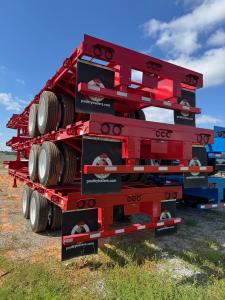
Enhancing Biosecurity in Poultry Transport with Best Cleaning Practices and Specialized Equipment
A core part of this effort lies in adopting best practices for cleaning and disinfecting transport equipment — particularly live haul trailers — and choosing designs that support biosecurity from the ground up.
According to Dwayne Walker, founder of Walker Poultry Trailers, biosecurity measures are only as strong as the equipment allows.
"Proper cleaning starts with how a trailer is built," said Walker. "Smooth interior surfaces, fewer trap points, efficient drainage, and accessibility for thorough washing all factor into how well a trailer can be sanitized between loads."
Effective cleaning protocols for poultry transport equipment involve a multi-step process designed to eliminate organic matter, pathogens, and cross-contamination risks. Best practices include:
Pre-wash Removal: Before any washing begins, loose organic material such as feathers, dust, and manure must be physically removed from all surfaces using blowers, scrapers, or brushes.
Initial Wash: High-pressure, low-volume water systems are used to remove residual organic matter, focusing on cracks, seams, and flooring where contaminants can collect.
Detergent Application: Application of appropriate detergents helps break down biofilms and organic residue that can harbor bacteria and viruses. Dwell time is critical for maximum effectiveness.
Disinfection: Following a complete rinse, EPA-approved disinfectants are applied according to label directions, ensuring adequate contact time to kill remaining pathogens.
Drying: Trailers must be thoroughly dried before reuse. Moist environments encourage pathogen survival and multiplication. Adequate drying reduces risk and prepares the equipment for safe transport.
Walker emphasized that design features play a major role in supporting these practices. Trailers constructed with corrosion-resistant materials, rounded corners, open-access spaces, and non-absorbent flooring significantly improve cleaning outcomes and reduce maintenance challenges over time.
"Designing poultry trailers specifically for easy cleaning not only protects animal health but also minimizes downtime between loads," Walker explained. "The right equipment keeps operations moving efficiently while meeting increasing biosecurity standards demanded by the industry."
States like North Carolina and Georgia, leaders in national poultry production, have already adopted stricter protocols across live haul operations. Regulatory and industry groups continue to emphasize the need for enhanced biosecurity practices to protect flocks from outbreaks such as avian influenza, Newcastle disease, and other costly health threats.
Arkansas, Alabama, Texas, and Mississippi are also reinforcing transport-related biosecurity as part of broader farm-to-plant initiatives. In these regions, trailer sanitation practices are no longer considered optional — they are a core expectation for maintaining certification, plant access, and operational credibility.
Choosing purpose-built poultry live haul trailers designed for rigorous cleaning not only supports compliance but offers tangible operational advantages. Benefits include faster turnaround times between loads, lower cleaning and labor costs, extended trailer lifespan, and improved animal welfare through cleaner transport environments.
Modern poultry trailer designs further support biosecurity through features such as:
Self-draining floors to prevent standing water
Smooth welds to eliminate bacterial harborage points
Access doors for comprehensive washing reach
Removable or modular components for deep cleaning
Ventilation designs that optimize airflow without compromising sanitation
Each of these features contributes to reducing the overall pathogen load that can travel from farm to farm, a key factor in minimizing the risk of flock-wide outbreaks.
Walker Poultry Trailers continues to focus on building equipment that meets the evolving needs of poultry producers in major poultry-producing states. Emphasizing durability, cleanability, and operational efficiency, these trailers align with industry best practices for biosecurity without sacrificing transport effectiveness.
Looking ahead, the poultry industry’s investment in stronger live haul sanitation standards is expected to continue growing. Processors and integrators increasingly view biosecurity during transport as an integral part of overall flock management and brand protection.
Building a comprehensive biosecurity plan that includes the right equipment, strict sanitation protocols, and trained personnel positions poultry operations for long-term success. In a highly competitive and regulated market, attention to every detail — including how birds are moved — helps protect production, market share, and food safety.
Morgan Thomas
Rhino Digital, LLC
+1 504-875-5036
email us here
Visit us on social media:
Facebook
Distribution channels: Agriculture, Farming & Forestry Industry, Automotive Industry, Culture, Society & Lifestyle, Food & Beverage Industry
Legal Disclaimer:
EIN Presswire provides this news content "as is" without warranty of any kind. We do not accept any responsibility or liability for the accuracy, content, images, videos, licenses, completeness, legality, or reliability of the information contained in this article. If you have any complaints or copyright issues related to this article, kindly contact the author above.
Submit your press release

